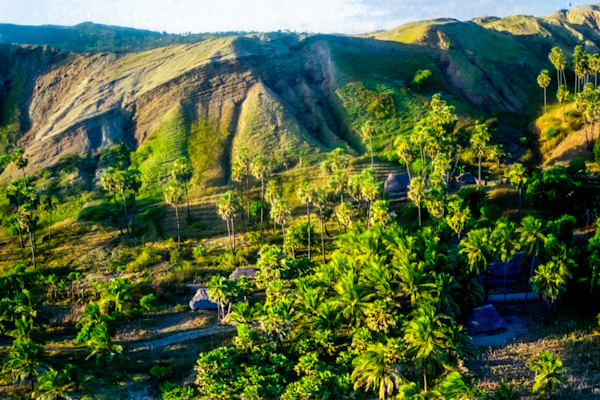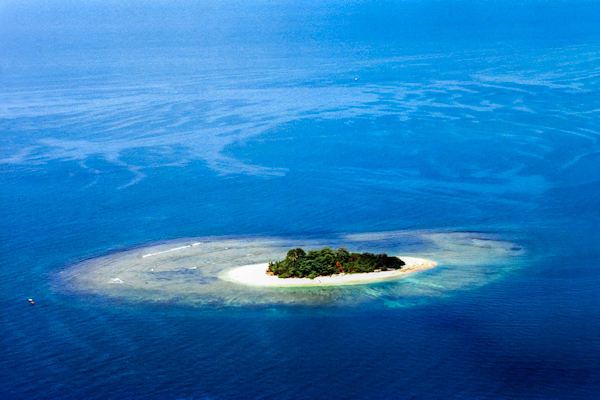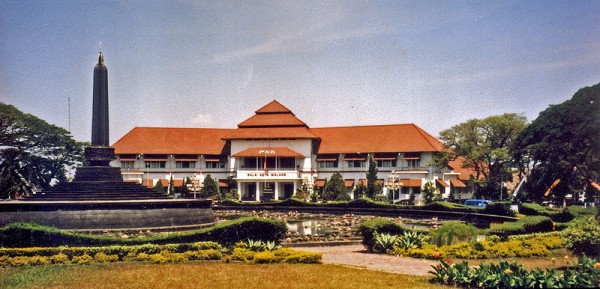The province of Riau include parts of central east Sumatra and the Riau islands south to the Berhala strait, north to the Singapore strait and east including the Natuna islands. The provincial capital is Pekanbaru on mainland Sumatra. Population is about 2.7 million, of which a third lives on the islands.

Riau is the largest province on the island of Sumatra.
With more than 3.000 islands spread over more than 1.000 km of sea it is often considered as a separate region. Mainland Riau covers an area of nearly 94.562 square kilometers, about seventy percent of this area is covered with forest. The archipelago part of the province occupies a total area of 1.176.530 square kilometers, consisting of sea and 3.214 islands, 743 of which are still unnamed, varying in size from 1.140 square kilometers (Bintan) to small corral reefs. The biggest islands are Bintan, Batam, Lingga, Singkep and Natuna Besar. Tanjung Pinang on Bintan island were before World War II the provincial capital, and is still the largest city on the Riau islands.
Climate:
The climate is tropical with two seasons, a wet monsoon season from about October/November to March and a dry season from June to October. Daytime temperatures average 30°, night temperatures 22° Celsius.
Flora and fauna:
The Riau province today has a high development rate and large agricultural areas, but still there are some spots with original, tropical rainforest and wildlife. The marine life are extra rich, especially in remote areas like Natuna. On the Sumatra mainland much of the region consist of forests and mangrove swamps. Here you can find rare species like the Sumatra rhinoceros and Sumatra tiger, and also bears, tapir and elephant.
People and Religion:

Riau have a population of about 2.7 million, of which about 100.000 are foreign nationals. Approximately one third of the population live on the islands and only about one fifth of the people live in towns. Few places in Indonesia has a more complex population than the Riau archipelago, here is a mix of Malay, Bugis (or “orang laut” which literally means the “sea people”, also called “sea gypsies”), Batak, Javanese, Minangkabau, Chinese, Arabic, Indian, Benua (the indigenous population) and of course people from other areas in Indonesia. The majority of the population is Malay, again split into several sub-groups. The main religion is Islam.
Economy:

The major industries in Riau are mining of tin and bauxite, oil and gas, rubber and lately a growing tourism. In addition there are of course many who work with traditional agriculture and fishing, the seas around the Riau islands are among the richest in Indonesia. About sixty percents of Indonesia’s oil come from oil fields in Riau, such as Minas and Duri. The “black gold” run in pipelines from wells inside the forest to refineries, the town of Dumai on the east coast of Sumatra is now an important oil terminal with millions of barrels of crude and refined oil shipped all over the world. The capital Pekanbaru on the Sumatra mainland is another modern oil town in the middle of one of the richest oilfields in Indonesia. Huge plantations contribute to another source of Riau’s wealth; palm oil.
The Batam and Bintan islands can easily be accessed from Singapore by boat, and has become a popular tourist destination for the Singaporeans. Batam is officially a center for industry and Bintan for tourism, and both islands saw huge investments before the economic collapse in the late 1990’s. There is a modern international airport on Bintan with good connections.
History of Riau:

As long as history can tell the Riau islands has been inhabited by the Malay and the Orang Laut (sea nomads) people, later over thousands of years migrants from a large part of south Asia, southern China and Indochina has settled here. Located along one of the world’s oldest and busiest trade routes, the Strait of Malacca, ships sailing between Europe, India and China has always found a safe haven here. That is, if they were not captured by pirates. Pulau Bintan and Temasek (the old name for Singapore) were in Chinese maritime records from the first half of the 14th century mentioned as a bastion of Malay pirates. The could use two to three hundred boats to force ships returning with trade goods into their harbors and attack those who refused. Evidence of this “trading” is found in Bintan and Singkep where large quantities of Chinese ceramics, some from the early Sung Dynasty (960-1127) have been unearthed. With the aid of the northeast monsoon wind in December Chinese vessels would use at least three weeks to reach the north coast of Bintan, where the highest mountain, Gunung Bintan Besar, where an important landmark.
Riau was for centuries a prominent dominion of the Srivijaya Empire, and provided skilled seamen and ships that was vital for the Srivijaya kings to control the Malacca Strait and the trade. The rise of Malay power first began somewhere around the 13th century, when the Srivijaya Empire began to crumble. Malay kingdoms emerged on both sides of the Malacca Strait, in 1290 a member of the royal family of Palembang named Sri Tri Buana (also called Sang Nila Utama) sailed to Bintan and proclaimed himself as king both there and on Temasek (Singapore). One day he was off Tanjung Bemban (Batam) he saw the white beaches of Temasek and decided to land there to investigate the area. He then saw an animal that was described to him as a lion, and he therefore renamed Temasek to Singapur, the lion city.
Malay kingdoms now emerged on both sides of the Malacca strait, and the Malacca kingdom was founded in 1402 by Parameswara, this kingdom also included mainland Riau. In the following century it played a major role in this region, and was the first to establish contact with Europeans and other visitors that came by sea. To be able to communicate with the people of the region the visitors quickly adapted Malay as the official language, and today Malay is the official language in Indonesia, called Bahasa Indonesia. The Riau islands became a part of the Malacca Sultanate during the rule of Sultan Mansur Shah (1459 – 1466). The Malacca empire then included Kedah, Trengganu, Pahang, Johor, Jambi, Kampar, Bengkalis, the Karimun Islands and Bintan.
The arrival of the Portuguese was the beginning of the end of the Malaccan empire. Malacca fell to the Portuguese in 1511, Sultan Mahmud Shah fled to Pahang and then to Pulau Bintan in 1521, where the small Pulau Penyengat island became the capital of the Johor-Riau kingdom from 1513 to 1526, and later from 1722 to 1819 (see Bintan). The Sultan successfully defended his kingdom against the Portuguese, and even managed to lay siege on Malacca in 1524. The Portuguese however counter attacked and destroyed his capital. Sultan Mahmud then fled to Sumatra where he died in 1528. Sultan Alauddin followed as ruler of the kingdom, and continued the fight from Johor. The following years there was continuous wars between Portuguese, the Johor Sultanate and the Achehnese of northern Sumatra, the so-called “war triangle”.
Early in the 18th century the descendants of the Sultan and the Regent of Johor where fighting for power. Bugis aristocrats from Sulawesi was asked to assist the Regent of Johor, and managed to achieve control of Riau due to the internal struggle between the members of the Johor empire, this allowed them to install a puppet ruler to rule with Bugis instruction. The Bugis were great traders and made Riau emerge as an international trading center. Riau also soon attracted British, Chinese, Dutch, Arabic and Indian traders.

The Dutch however started to look upon Riau and the Bugis as a dangerous rival to Dutch trade in the region, drawing away trade from their ports in Malacca and Batavia (Jakarta). They were also concerned about the rise of Riau as a political and military power. A Dutch fleet of 13 ships and 1.594 men attacked Riau in 1784 but failed to hold the islands for more than three months. Another attempt later the same year also failed when the commanding officer’s ship blew up. A Dutch battle fleet from Batavia with 6 ships and 2.130 men finally broke the Bugis blockade of Malacca in June 1784. The famous Bugis commander Raja Haji was killed during battle and the Bugis units retreated, which opened the way for a Dutch counter attack on Riau. The Bugis was expelled from Riau, and a treaty between the Dutch and the Malay Sultan granted Dutch control over the area. Another treaty signed in 1787 restricted Malay and Bugis rights.
The treaties caused much anger among the Malay rulers, and again in 1787 the Dutch was driven out by a force from present day Sabah, invited by the Malay rulers and offered refuge by Sultan Mahmud. This led to the return of the Bugis and the rivalry between Bugis and Malay. Peace between the two parties was finally reached in 1803. Around this time Sultan Mahmud gave Pulau Penyengat as a wedding gift to his bride, Raja Hamidah, daughter of Raja Ali Haji. Penyengat became for a period again the center of government, and also of the Islamic religion and the Malay culture. This ended when the last Sultan of Riau-Lingga, Abdul Rahman Muazzan Shah, left because he was not willing to sign a contract with the Dutch that terminated the rights of the rulers of Riau. To prevent his properties to fall into Dutch hands he ordered his people to destroy the royal buildings.
The directors of the English East India Company at Penang ordered a search for a suitable port on the eastern side of the Bay of Bengal, and Bintan was suggested. However, since the Dutch had already attacked Bintan in 1784 the English chose to continue their settlement on Penang. In 1812 they finally realized that Penang was unsuitable, and unsuccessfully tried to make Riau an British protectorate, but the Dutch beat them to it. Stamford Raffles was then told that there was no Dutch settlements on the Singapore island, and in 1819 an agreement allowed the English to set up a trading post there.
The Treaty of London in 1824 finally settled that Singapore and Johor were British territories and the area south of the Singapore Strait Dutch territories. This area included Riau, and effectively severed its links with Johor and the mainland. The Dutch interest in Riau was primarily to get rid of the pirates that had become a serious problem for the trade, and they did not interfere much with the inner affairs of Riau.In 1942 Riau was occupied by the Japanese, and in 1945 it became part of the Riau province of the Republic of Indonesia. Pekanbaru became the provincial capital in 1959.
Art and culture:
On the Riau islands the legacy of the early kingdoms is still clearly visible among the Malay population, but with the strong contact with the outside world these traditions has started to erode, especially among the younger generation. The large number of immigrants with other cultures and traditions has of course also had a strong influence, and the culture here can hardly be called exclusively Malay anymore. Some traditional festivals and ceremonies can however still be seen here.
The Bustanul Katibin, the first book of Malay grammar was written and published here in 1857. Malay is today the official language of Indonesia and Malaysia. Still there are some nomadic tribes that live in the jungle of Sumatra’s part of Riau. In Pekanbaru there is a museum and a culture park if you like to learn more about this area.
Travel and transport:

Even if Riau is geographically divided the communications are rather good. The roads on mainland Riau has greatly improved in the past few decades, and the towns along the east coast and neighboring provinces can easily be reached by car. Boats are frequently sailing between the islands, and both Pekanbaru and Batam are serviced with direct flights to Jakarta, Singapore and other cities on a daily basis
axis with a testosterone assay How to get viagra every patient receiving treatment for ED. The goals of.
. If you plan to travel to Riau you should decide in advance which part you want to see first, the mainland or the islands. Pekanbaru is the easiest place to travel to on mainland Riau, from there you can go on to the other parts of the province
. If you want to visit the islands and come from Singapore or Jakarta the most convenient gateway is Batam or Bintan. Bintan is maybe the most interesting island if you have to choose between the two. There are good communications between Singapore and Batam and Bintan islands, with speedboats sailing frequently every day from the World Trade Center in Singapore.

Natuna is the most remote of the islands, but there are boats sailing to Natuna from Tanjung Pinang on Bintan, though not very frequently. Some of the Natuna islands can also be reached from West Kalimantan.
General:
Malaria is known to exist here and you should take your normal precautions.









